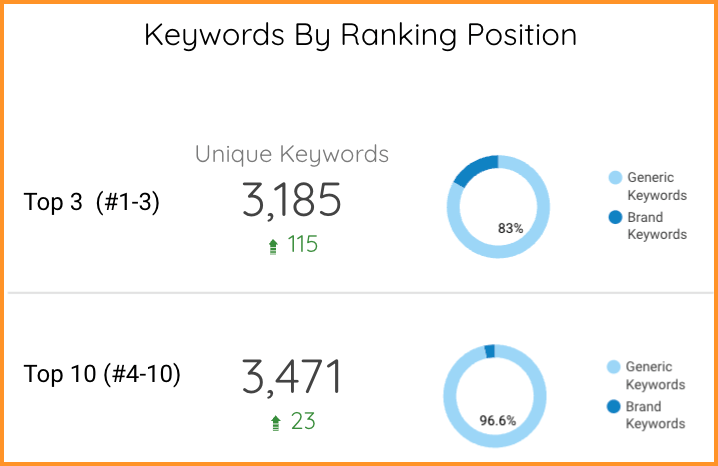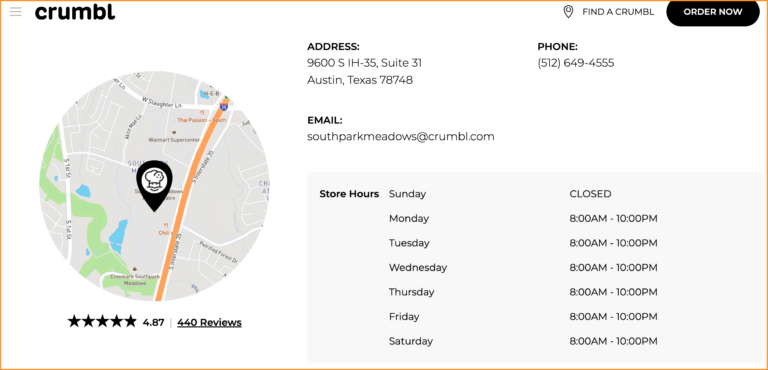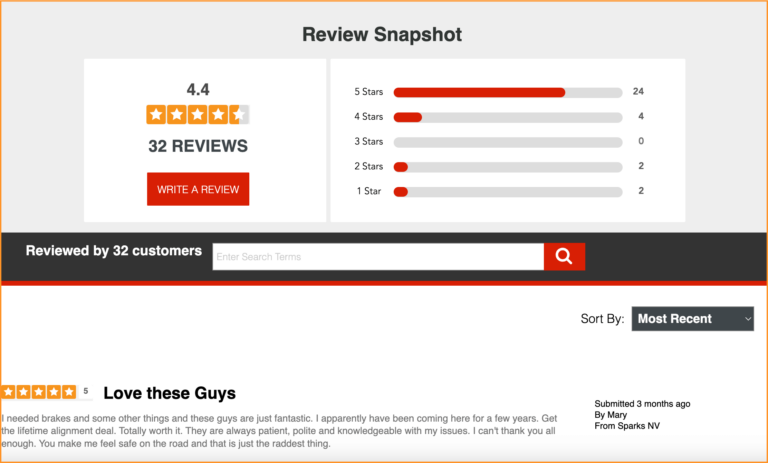SEO will still have a place in an AI future. Make sure your brand is prepared.
Discover our must-have ingredients for local landing pages that rank high and convert.
Local landing pages are a crucial part of any local SEO strategy. They can draw in-store traffic to your brick-and-mortar locations, increase appointments booked in your service areas, and much more. But for a local page to perform well, it needs to be optimized. But what does “optimization” mean? We break down local landing pages, their importance, and our top tips for creating pages that increase online and in-person visits.
A local landing page is a webpage designed to attract visitors from a particular geographic area. These pages target location-specific keyphrases to capture searches for local goods and services, making them essential for both small and multi-location businesses.
You should publish four main types of local pages (if relevant): location, city/service area, category, and state.
Location pages are created for physical locations. (Ex: Dutch Bros at 1815 E Parmer Ln)
City/service area pages represent the city where you have one or more physical locations or where you provide services. (Ex: Dutch Bros in Austin, TX or Plumber in Austin, TX)
Category pages are for the service or product categories you offer within your localities. (Ex: Coffee in Austin or Iced Tea in Austin)
State pages are created for the states where you have physical locations or service areas. (Ex: Dutch Bros in Texas)
You may add other types of local pages, such as postal codes, counties, nearby cities, or neighborhoods, but these four are the most common.
According to a Statista survey, 21% of consumers report using the internet to find local businesses daily. Don’t miss out on all those potential customers!
Without geo-optimized local pages, it’s difficult for your brand to appear for city- or state-specific searches, and you definitely won’t be at the top of the search results page. These pages can bring more visitors to your website from local queries. Online visitors can then become in-store visitors after viewing your local pages.
Block quote: GPO local pages contribute about 30% of the overall organic traffic and 35% of total appointments for one national auto repair shop with 1,200+ locations.
Non-branded keyphrases are crucial for raising brand awareness and attracting new customers. Not everyone searches for specific brands. For example, “pizza hut near me” has a monthly search volume of 823k (according to Semrush), while generic “pizza near me” has 6.1 million — more than six times the search volume! Optimized local pages help you capture impressions and clicks for tons of relevant non-branded keyphrases with local intent. They help you be discovered!
The screenshot below shows the non-branded (or generic) vs. branded breakdown of ranking keyphrases for a client’s local pages. Most local page keyphrases ranking in the top 10 positions are those valuable non-branded (or “generic”) terms.

Local pages also enhance the customer experience. Share NAP (name, address, phone) information, store hours, directions, customer reviews, and more on the location-level pages. Customers can use all this information to book appointments or make in-person visits. The right information and clear, well-placed calls to action can boost conversions.
Note that search engines and local directories use your local pages to validate Map accuracy. For example, even if you have the correct hours on your Google Business Profile but forget to update the store’s local page, Google will often update the Business Profile to be consistent with the information provided on your site.
You need well-written, optimized local landing pages to rank high in search, especially for non-branded keyphrases. Having created tens of thousands of high-performing local pages, here are 10 tips we find help our pages perform better.
You can’t rank for a location-specific search if you don’t include that location in your content. Sprinkle geo-modifiers where appropriate throughout your page.
Let’s say you own a chain of coffee shops called The Daily Grind. You want to include geo-modifiers around your business name, like “The Daily Grind in San Antonio, TX.” You should also include them around relevant keyphrases, such as “coffee shop in Austin” or “lattes near me in Cedar Park.”
Keyphrase research will help you find the best location-based and “near me” terms to target. Almost 6 million keyphrases include the words “near me” (accounting for more than 825 million monthly searches), so finding relevant keyphrases is easier than you think!

Add geo-modifiers to your metadata. Include the city/state/street name/address in your title tag, meta description, and URL structure. Here is an example from Uncle Julio’s. We see them incorporate geographic information naturally in all three places.


When working with multiple locations, you need to be mindful of duplicate content. You’ll appear spammy to Google if you have identical content across multiple pages. Publishing the same content with only the geographic information swapped out won’t be enough. You need to make each page unique.
If you have a handful of locations, your team might be able to write individual pages. But if you’re faced with tens or hundreds of locations, you likely don’t have enough time or resources to dedicate to the project. Turn to a company like GPO that can ensure each city, location, category, state, etc., page has high-quality, unique, and helpful content.
High-quality images can boost your rankings and make your pages more engaging. You don’t even have to take professional photos of each location. You can use topically relevant images (like pizza for a pizza restaurant) across your pages. Make sure you add alt text with geo-modifiers.
Local pages are a great place to enhance your internal linking strategy. Internal linking is key for any site that wants higher rankings in Google. It helps Google find, index, and understand all of the pages on your site. Strategic linking can send page authority (or PageRank) to important pages.
Use your local pages to link to relevant blog content, products, category pages, FAQs, nearby locations, etc. And don’t forget to link back to your local pages from other places on your site where possible.
Mark up your local pages with the appropriate schema to help search engines better understand what your content is about. Use Breadcrumb schema for the parent city, state, category, etc., pages. For location pages, using LocalBusiness is crucial for local search visibility.
You can add other schema relevant to your business, like Restaurant or AutomotiveBusiness, as you see fit.
Drive organic traffic to your local pages by linking to location-level pages from their matching Google Business Profiles. By linking to your location page, you also tell Google the exact words, concepts, products, and services to associate with your listing, improving your Maps ranking. Considering that 42% of local searchers click on the Google Map Pack, this strategy helps you capture traffic from searchers clicking on the map pack AND searchers clicking on the traditional blue link.
The example below shows a Crumbl listing that links to the location’s landing page.

Linking from your GBP also creates a better experience for the user. When clicking from a business listing, would you rather land on a generic home page or local landing page with all the store information you need?
Speaking of location information you need, ensure every location page includes NAP information, a map, and hours of operation. This information is necessary for customers to reach out or visit your storefront, increasing your conversion rate.
Following the above example, clicking on the link from Crumbl’s Business Profile takes you to a landing page with all the store and contact information you’d want — address, phone number, hours, map image, and even an email address.

Reviews increase sales by 18% on average. Build trust and stand out by adding a feed of customer reviews to each location page. Reviews show your location is real and has a good reputation. You can embed reviews straight from sites like Google.
Tires Plus is an excellent example of review sharing done well. Their location-level pages include a quick snapshot of their overall review rating followed by in-depth text reviews beneath.

Nearly a third of mobile searches are related to location. You don’t want mobile searchers to click on your result and land on a wonky page. Ensure your location pages are responsive and load quickly on mobile formats. Don’t forget to test your design across multiple devices, such as different tablet and phone browsers.
The above tips are must-haves for any successful local page strategy. We have a few ways you can take your pages a step further, though.
Local pages for job openings and hiring info can help extend your reach while searching for employees, especially if you’re in retail or another industry with higher employee turnover. You can create category-style pages for open positions in certain cities (like Customer Service Representative in Houston) to draw more applicants.
Let online searchers meet the team. Include store managers’ or franchisees’ faces and names to make customers feel more connected to your business. If you own a company that requires employees to be inside or around homes (plumbers, cleaners, landscapers), including employee pictures can help customers feel more comfortable hiring your business.
Creating engaging, quality content for hundreds or thousands of locations is a tough job to tackle on your own. GPO is ready to help with our local pages. With human-written, machine-powered content, we can quickly create unique, quality landing pages for your brand. Contact us to learn more and meet your customers where they’re searching today.

SEO will still have a place in an AI future. Make sure your brand is prepared.

Discover our top tips for including external and internal links in your SEO content.

Check out eight books that have impacted GPOers in their personal and professional lives.
